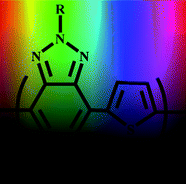Processable donor–acceptor type electrochromes switching between multicolored and highly transmissive states towards single component RGB-based display devices†
Abstract
Donor–acceptor (DA) type

* Corresponding authors
a
Department of Chemistry Middle East Technical University, Ankara, Turkey
E-mail:
toppare@metu.edu.tr
Fax: +903122103200
Tel: +903122103251
Donor–acceptor (DA) type

 Please wait while we load your content...
Something went wrong. Try again?
Please wait while we load your content...
Something went wrong. Try again?
A. Balan, D. Baran and L. Toppare, J. Mater. Chem., 2010, 20, 9861 DOI: 10.1039/C0JM01815E
To request permission to reproduce material from this article, please go to the Copyright Clearance Center request page.
If you are an author contributing to an RSC publication, you do not need to request permission provided correct acknowledgement is given.
If you are the author of this article, you do not need to request permission to reproduce figures and diagrams provided correct acknowledgement is given. If you want to reproduce the whole article in a third-party publication (excluding your thesis/dissertation for which permission is not required) please go to the Copyright Clearance Center request page.
Read more about how to correctly acknowledge RSC content.
 Fetching data from CrossRef.
Fetching data from CrossRef.
This may take some time to load.
Loading related content
